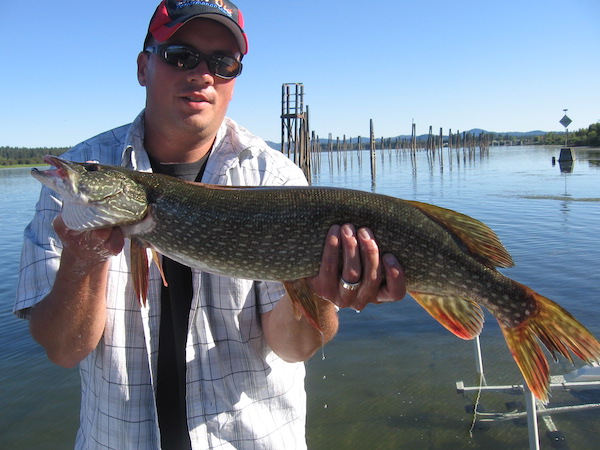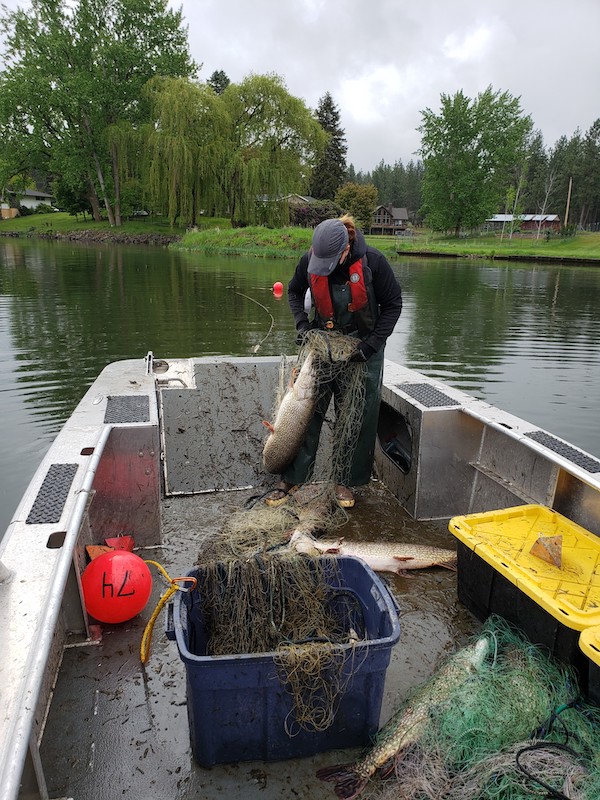
Illegal Pike Release Sped Up Native Fish Decline In NE WA Lake
The illegal introduction of northern pike in a Northeast Washington reservoir sped up the decline of native fish species there, with their biomass dropping by more than half, and it also affected some popular nonnative species, while others only grew stronger.
That’s according to a recent Washington Department of Fish and Wildlife paper that looked at how various fish populations responded to the arrival and rise of Esox lucius in Box Canyon Reservoir on the Pend Oreille River between Newport and Ione and efforts to suppress the toothsome invasive fish, and is based on long-term electrofishing surveys and gillnetting removal data.

“As an apex predator, northern pike had a significant impact on the fish community of Box Canyon Reservoir in a relatively short period of time (seven years) and likely acted as a catalyst to increase the rate of replacement of native species by nonnative species,” write agency warmwater biologists Kent Mayer and Danny Garrett in their 34-page report.
Native fish biomass fell from 36 percent in 2004 – when pike were first confirmed – to 16 percent in 2019 as populations of largescale and longnose suckers, mountain whitefish, northern pikeminnow, peamouth chub – which suffered a 99.6 percent drop – and redside shiners – not seen since 2004 – all crashed.
Nonnatives largemouth bass, black crappie and pumpkinseed sunfish – all popular game fish species – also saw sharp dropoffs, at least at first, but they’ve begun to recover following pike removals, though were still shy of pre-northern levels as of 2019.
“Winner” species included nonnative brown trout and smallmouth bass, numbers of which “increased significantly” from 2004 to 2019, while for fellow import yellow perch it was a mixed bag, with both declines and increases seen, depending on habitat and capture method.
Mayer and Garrett state that replacement of the Pend Oreille’s native fish “probably began” when the river was dammed in 1955, creating a pool “more suitable to nonnative species and less suitable for native, riverine species.”
That process continued with the intentional and illegal releases of nonnatives – walleye and grass pickerel are just the latest newcomers here – and then when pike were dumped into the reservoir, their diet preference for soft-rayed and taper-ended native fish exacerbated the decline.
Initially it was believed that the pike were coming down the Clark Fork River (which becomes the Pend Oreille) from an infestation in Northwest Montana, but subsequent genetic evidence pointed to the Coeur d’Alene River’s Chain Lakes and “human transport.” It appears that a “small number” of northerns were brought by a bucket biologist or bucket biologists somewhere in perhaps the late 1990s or early 2000s.
Their numbers mushroomed to an estimated 10,000-plus fish by 2010 and they were a seed source for subsequent downstream colonizations in Boundary Canyon Reservoir and Lake Roosevelt.
With both WDFW and the Kalispel Tribe of Indians agreeing early on that pike were “a problem, not an opportunity,” tribal gillnetting on Box Canyon began in 2012, and the efforts have been wildly successful. Northern numbers and biomass has been reduced 97.3 and 98 percent, respectively, according to the WDFW biologists. Through last year, 19,430 pike have been removed there, per WDFW.

It all sparked an apparent rebound in largemouth. Electrofishing results show a population crash between 2004 and 2011 surveys, but after pike suppression began, largemouth numbers began to grow again, though they were only one-quarter to one-half of pre-northern levels as of 2019.
Mayer and Garrett do say that sans a creel survey, it’s uncertain how the arrival and suppression of pike has affected bass fishing, but longterm tourney data – with its many sloughs, Box Canyon was best known for its largemouth fishing in the past – does show a corresponding decline and rise in catch rates.
They went from .36 per hour in 2009 to .26 in 2010 and remained in the .19- to .28-fish range from 2012 through 2015, before climbing back to .37 fish per hour in 2016.
“The decline in catch rates between 2010 and 2015 is likely a reflection of the decrease in the largemouth bass population during northern pike colonization, and the increase in their abundance after suppression,” the biologists write.
Meanwhile, smallmouth bass numbers have taken off, growing from just 30 fish captured in 2004 to 62 in 2011, 198 in 2014 and 461 in 2019.
They and German browns “appeared to show little effect from the introduction and colonization of northern pike.” The trout are mostly electroshocked out of the river portion of the reservoir rather than its sloughs, at least during state sampling periods.
But where the pike that initially decimated peamouth, pikeminnow and whitefish populations are now mostly gone, the two bass species as well as browns “may also have played a role in preventing their [the native species] potential recovery.”
What anglers and biologists have seen at Box Canyon is the “pike-driven homogenization” of a relatively shallow, weedy reservoir. All totaled, there was a 55 percent decline in native fish biomass and 31 percent increase in nonnative ones over a 15-year period.
It’s not a unique story. But using longterm data collected by state and tribal biologists, the WDFW paper by Mayer and Garrett fleshes out more fully the downstream impacts of the selfish actions 20-some years ago of one person or a handful of people who emptied out a livewell or dumped the contents of a bucket into Box Canyon Reservoir and the Pend Oreille River.

